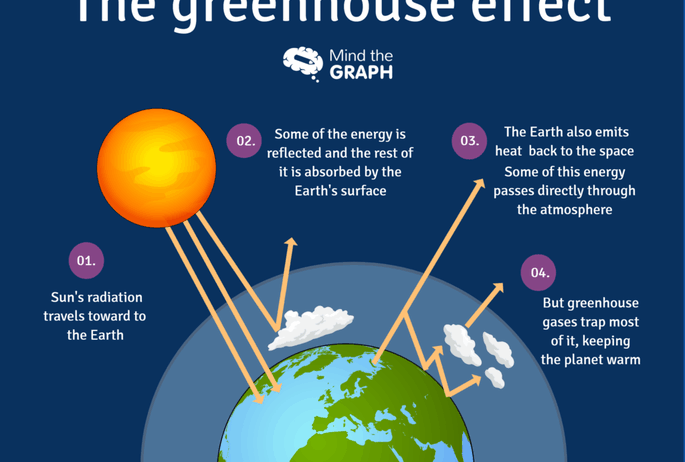The greenhouse effect is a natural phenomenon that plays a pivotal role in shaping our planet’s climate. It occurs primarily within the Earth’s atmosphere, a complex layer of gases that encases our world. But where exactly does this effect come into play, and how does the atmospheric composition influence it? This article seeks to unravel the mysteries surrounding the interactions between the atmosphere and the greenhouse effect, urging a deeper understanding of the intricate systems at work.
At its core, the greenhouse effect is a result of the interaction between solar radiation and the Earth’s surface. When sunlight reaches Earth, a portion of it is absorbed, warming the surface. The Earth, in turn, emits this energy as infrared radiation. Greenhouse gases in the atmosphere, such as carbon dioxide, methane, and nitrous oxide, trap some of this outgoing radiation, thereby preventing it from escaping back into space. This retention of heat is essential for maintaining a climate that supports diverse forms of life; however, an excess of these gases can lead to an enhanced greenhouse effect, resulting in global warming and climate change.
Understanding where the greenhouse effect occurs requires a closer examination of the Earth’s atmospheric layers and the role each plays in this environmental phenomenon. From the troposphere to the stratosphere, the atmosphere is stratified in layers, each serving unique functions. Delving into these layers sheds light on the complexities of the greenhouse effect.
Stratospheric Insights: The Role of the Ozone Layer
The stratosphere is the second layer of the atmosphere, positioned above the troposphere. One of its most vital components is the ozone layer, which plays a dual role in climate dynamics. Not only does it absorb a significant portion of the sun’s harmful ultraviolet (UV) radiation, but it also influences temperature distribution in the stratosphere. With the ozone absorbing UV radiation, it warms the stratosphere and prevents excessive heat from accumulating in the lower layers of the atmosphere. This layering of temperature and atmospheric pressure affects weather patterns and, by extension, the greenhouse effect.
Interestingly, the depletion of the ozone layer through human activity has implications beyond UV exposure. Reduced ozone concentrations can alter the thermal balance of the stratosphere, potentially leading to changes in weather patterns and climate over time. Thus, the interconnectedness of atmospheric layers becomes crucial for understanding the broader implications of the greenhouse effect.
Tropospheric Dynamics: The Heart of Weather and Climate
Descending to the troposphere, where nearly all weather phenomena occur, we find ourselves at the epicenter of the greenhouse effect. The troposphere is primarily composed of nitrogen and oxygen, but it also contains water vapor and greenhouse gases. Here, the phenomenon of the greenhouse effect finds its most poignant manifestation. Water vapor, a potent greenhouse gas, is responsible for much of the natural greenhouse effect, allowing our planet to maintain temperatures conducive to life.
In the troposphere, human activities are significant contributors to the accumulation of greenhouse gases. The burning of fossil fuels, deforestation, and industrial processes release substantial quantities of carbon dioxide and methane, exacerbating the greenhouse effect. The consequences of these changes are far-reaching, influencing global temperatures and precipitating extreme weather events.
The interaction between these gases and the solar energy absorbed by the planet causes a ripple effect on climatic systems, highlighting the significance of the troposphere in environmental dynamics. As a result, understanding the role that human activities play within this layer not only informs climate action strategies but also piques curiosity about our potential solutions.
Mesosphere and Thermosphere: Lesser-Known Players
While the troposphere and stratosphere enjoy more spotlight in discussions about climate, the mesosphere and thermosphere contribute to the overarching narrative of atmospheric behavior. Although these layers are more tenuous and are not directly implicated in the greenhouse effect, they contribute to the overall temperature structure of the atmosphere and influence atmospheric circulation patterns.
The mesosphere acts as a buffer between the stratosphere and the thermosphere, absorbing and redistributing energy that ultimately influences weather. Meanwhile, the thermosphere, though vast and primarily lacking in mass, experiences significant heating due to solar radiative energy. It is here that atmospheric phenomena such as auroras occur, creating visual spectacles that underscore the dynamic nature of our atmosphere.
With a deeper understanding of the atmospheric layers and their roles, it becomes apparent that the greenhouse effect is not merely a simplistic cycle of absorption and release. Instead, it is intricately connected to the diverse phenomena occurring within our atmosphere. Promoting awareness about these layers and their functions nurtures a holistic appreciation for the environment that sustains us.
Conclusion: A Call for Awareness and Action
The greenhouse effect is fundamentally tied to the Earth’s atmospheric composition, with each layer contributing uniquely to its mechanisms. By grasping the delicate balance of our atmosphere and recognizing the anthropogenic influences that disrupt it, we can foster a more informed discourse surrounding climate action. This understanding not only piques curiosity about the science behind atmospheric dynamics but also promises a shift in perspective, encouraging individuals and communities toward proactive measures in combatting climate change.
As we consider the layers of our atmosphere and their interconnected roles in the greenhouse effect, it becomes evident that knowledge is a powerful catalyst for change. We must harness this knowledge in our quest for sustainability, advocating for actions that preserve and protect the delicate equilibrium of the Earth’s climate system.







